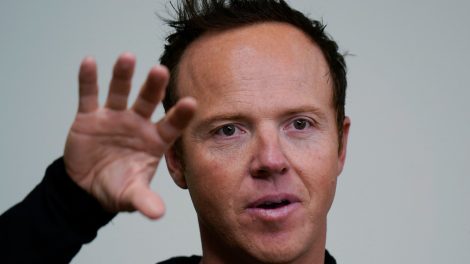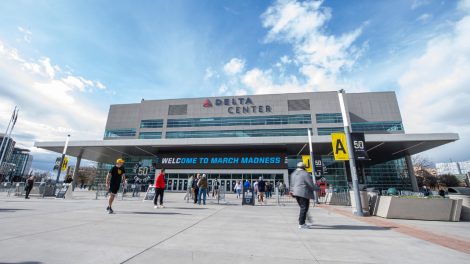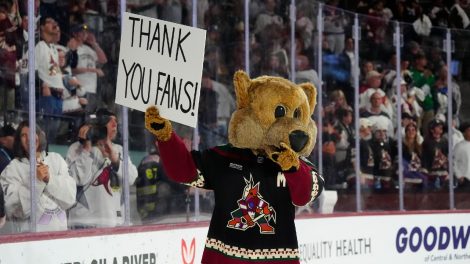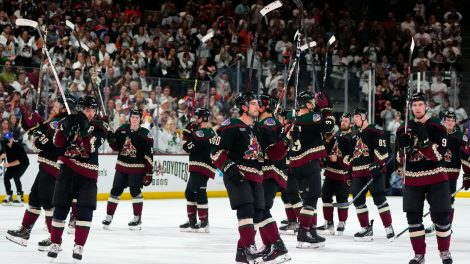The silly season is upon us. Each of the NHL’s 31 teams, even the champion St. Louis Blues, are beginning to look ahead to next season already. In the next two-plus weeks a flurry of activity will unfold, from the awards to the draft, free agency and more. We’re just getting started, so here are some key dates to keep in mind.
[snippet ID=3322139]
BUYOUT WINDOW: OPENS JUNE 15
Before we get to the draft, the negotiating window or free agency, NHL GMs will have their first opportunity to start clearing cap space when the buyout window opens at 12:01 a.m. ET on June 15 and runs through June 30. But while buyouts can offer short-term cap space, there is a bit of a penalty on the back end.
The cost of a buyout is paid out over twice the number of remaining years on the contract and the rate is one-third of the remaining salary (not cap hit) for players younger than 26, and two-thirds for players 26 and older. But any player who is still recovering from a regular-season injury cannot be bought out and a buyout can only happen after a player clears unconditional waivers.
However, any player who signed a contract at age 35 or older would not provide their team with any cap relief should they be bought out. Whatever the cap charge would be for that player remains exactly the same in the event they are bought out.
As always, CapFriendly is your destination for any questions you may have about this stuff. They have a great explainer on how you calculate a cap hit for a buyout and their buyout calculator lets you experiment with any player in the league.
NHL AWARDS SHOW: JUNE 19
The NHL returns to Vegas again for the 2019 awards show, which this year will be hosted by Kenan Thompson. You have to assume there’s going to be a knuckle puck or two that evening.
Should @kenanthompson wear skates when he hosts the 2019 #NHLAwards presented by @Bridgestone on June 19th?
Tickets available for purchase at https://t.co/V6e1qGVbJK pic.twitter.com/nP8eKXofOT
— NHL (@NHL) June 5, 2019
This year the show will be broadcast from the Mandalay Bay Events Center and will be shown in Canada at 8 p.m. ET on Sportsnet. Among the scheduled presenters this year are: Jay Baruchel, Kurt Busch, Jeopardy champ James Holzhauer, JB Smoove and more.
Award races of note:
Calder Trophy: At one point it seemed clear that Vancouver’s Elias Pettersson would win Rookie of the Year. And remember, all voting is done before the start of the playoffs, so nothing Jordan Binnington did in the post-season will help his case. But by the end of the regular season, some of the rookie conversation started to turn and the St. Louis Blues goalie was getting more credence as a front-running candidate. Pettersson ran away with the rookie scoring race all season long, finishing as the top goal scorer by six over Brady Tkachuk and the top point-getter by 21, also over Tkachuk. But the Canucks phenom did slow down, scoring just twice and recording 13 points in his last 23 games. Binnington didn’t become the starter until January and played only 32 regular season games, but he finished with a .927 save percentage and 24-5-1 record.
Selke Trophy: This one will be interesting to see because of the collection of players who were named finalists. Patrice Bergeron is the mainstay here and has already won it four times, which ties Bob Gainey for the most ever. But his two challengers have excellent cases of their own. Conn Smythe winner Ryan O’Reilly has long been regarded as one of the best two-way players in the game, but amazingly this is the first time he’s been a finalist for the Selke. And Mark Stone is the first winger to be named a finalist since Jay Pandolfo all the way back in 2006-07. If Stone wins, he’d be the first flanker to do it since Jere Lehtinen in 2002-03.
Full List Of Award Finalists:
Hart Trophy: Sidney Crosby, Nikita Kucherov, Connor McDavid
Vezina Trophy: Ben Bishop, Robin Lehner, Andrei Vasilevskiy
Norris Trophy: Brent Burns, Mark Giordano, Victor Hedman
Selke Trophy: Patrice Bergeron, Ryan O’Reilly, Mark Stone
Jack Adams Award: Craig Berube, Jon Cooper, Barry Trotz
Ted Lindsay Award: Connor McDavid, Patrick Kane, Nikita Kucherov
Calder Trophy: Elias Pettersson, Jordan Binnington, Rasmus Dahlin
Lady Byng Trophy: Aleksander Barkov, Sean Monahan, Ryan O’Reilly
King Clancy Memorial Trophy: Oliver Ekman-Larsson, Jason Zucker, Henrik Lundqvist
Mark Messier Leadership Award: Mark Giordano, Wayne Simmonds, Justin Williams
Masterton Trophy: Nick Foligno, Robin Lehner, Joe Thornton
GM Of The Year: Doug Armstrong, Don Sweeney, Don Waddell
[snippet id=3816507]
NHL DRAFT: JUNE 21-22
This year’s draft is taking place at Rogers Arena in Vancouver, B.C. Nowadays the NHL Draft is almost thought of as a second trade deadline, with a recent history of big trades happening around this event. Will 2019 continue that trend?
Jack Hughes is the favourite to go first overall after wrapping up this season as the USNTDP’s all-time leading scorer, but Finn Kaapo Kakko put on a late charge. At the start of the season there appeared no chance anyone would challenge Hughes, but Kakko set a goals record in Finland’s top professional league for a player his age and had a season comparable to Aleksander Barkov’s in his draft year. And although Kakko is listed as a winger, he may still become a centre in the NHL, which adds to his value.
After the Devils and Rangers pick those two in whichever order, most people would say the draft really starts at the third pick with the Chicago Blackhawks. There’s no clear choice at three, where a bundle of centres from Trevor Zegras to Alex Turcotte or Dylan Cozens could be had. There’s also defenceman Bowen Byram, who led the WHL in playoff scoring and was better than a point-per-game player in the regular season for the Vancouver Giants.
The Edmonton Oilers are the first Canadian team to pick and they’ll go eighth overall. The host Canucks will pick 10th, and in both cases, there again is no consensus on the order these players should go in. There’s a chance Vancouver could end up with a prospect at 10 who they had ranked inside the top six.
There are two intriguing prospects in this area who could end up with either Canadian team, or even fall out of the top 10. Russian Vasily Podkolzin has undeniable talent, and would probably be a slam dunk top-five pick had he played in the CHL. But he has two years left on his KHL contract with the intent to see that through, so there is at least some risk that he never comes to the NHL, or delays it even further.
Then there’s Cole Caufield, who set a new USNTDP goal scoring record this season as a five-foot-seven winger. Often compared to Alex DeBrincat, who slipped into the second round in his draft year, Caufield won’t be overlooked and may go inside the top 10. He’s the type of player who could fit with both the Canucks and Oilers.[sidebar]
Last year was a bit of a defence-heavy draft at the top, with five of the top-12 picks coming off the blue line. This year is different. Aside from Byram, who could go top five, the next highest-ranked defenceman on Sam Cosentino’s latest rankings is Victor Soderstrom at 14.
As far as the CHL goes, last year was a struggle for the WHL as only two players from the league were taken in Round 1. In 2019, though, the WHL could have four of the top-10 picks in 2019. This year looks to be lighter on talent from the ‘Q’ and Cosentino only had three players from that league ranked in his top 31. And while Cosentino had six OHLers in his top 31 from May, none fell inside the top 10. If that’s how the top of the draft plays out, it would be the first time the OHL isn’t represented in any of the first 10 picks since 1986.
Make no mistake: this is the year of the USNTDP. On top of having the No. 1 prospect, there will likely be at least seven prospects taken from the program in the first round.
Players Of Note:
Spencer Knight: It’s not too often you see a goalie taken in the first round anymore, and if it does happen it’s usually towards the end of the round. In the past three drafts, the only goalie taken on the Friday was Jake Oettinger (selected 26th overall by Dallas in 2017). But Spencer Knight, one of the USNTDP products, is being ranked in the middle of the round right now and might be targeted by one of the five teams with multiple first-rounders. He’s big at six-foot-three, 198 pounds, and was dominant at the under-18s.
Moritz Seider: A German defenceman out of his country’s top professional league, Seider is a late riser in the rankings. He’s a six-foot-four, 207-pound right shot defender who gained a lot of attention at the draft combine for his personality and how he handled questions from the teams and media. He got a couple goals for Germany at the World Championship, but his team wasn’t in the top WJC table this season. Given he played in the DEL instead of a more renowned league, his draft stock has been hard to gauge.
Brett Leason: He’s 20 years old and has already been passed over completely twice in the NHL Draft, but now he could have his name called on the first day and enjoy the pomp and circumstance that accompanies it. He started the season with a 30-game point streak, after which he had 64 points. Leason represented Canada at the WJC and was second in WHL playoff scoring en route to winning a championship with the Prince Albert Raiders.
UFA INTERVIEW PERIOD: OPENS JUNE 23
All impending UFAs can begin talking with any NHL team ahead of free agency opening on Canada Day. This is when free agents can start to get a handle on what their market will look like ahead of deciding whether to stay with their current team (assuming the club has been trying to re-sign them) or try for greener pastures. A pending UFA may still re-sign with his current team during this window, but nothing official can be signed with a new team until July 1.
RFA INTERVIEW PERIOD: OPENS JUNE 26
The deadline for teams to submit qualifying offers to their own RFAs is June 25 at 5 p.m. ET, so given that has to happen before an offer sheet can be signed, the negotiating window for these younger players opens a little later. Just like with the UFAs, these players can begin talking with any NHL team during this time, though no offer sheet can be signed until July 1.
You can read more about offer sheets, how they work and who could get one, in our primer.
FREE AGENCY: OPENS JULY 1
It’s tradition.
Once again signing season, the free agent frenzy free-for-all, will launch on Canada Day. And just like John Tavares last year, there is some real star power at the top of the UFA class.
Erik Karlsson is the kind of stud defenceman who rarely becomes available on the open market. He’s still in his prime at 29 years old and was excellent for the Sharks with 45 points in 53 games this season. But there is some concern about his injury history and that he ended the playoffs hurt. In early June, he had groin surgery and was seen on the court after an NBA Finals game in Golden State on crutches.
Erik Karlsson spotted in a GSW jersey on crutches. pic.twitter.com/tLNHJG1Iqc
— Mark (@MarkB_3) June 6, 2019
And how about Joe Pavelski? The Sharks captain was a seventh-round pick of the team all the way back in 2003 and the expectation was he’d eventually get a new deal done to stay in San Jose. But the closer we get to the interview period, the more we wonder if the 34-year-old will move on. It would leave a big hole in San Jose’s lineup, and add one of the most consistent point producers to some other roster. He is in his mid-30s though, so decline is in the rather near future.
That’s only the start of this class. Goalie Sergei Bobrovsky and winger Artemi Panarin are set to leave the Blue Jackets and make a big impact with a new team, while Matt Duchene could be the top centre available on the UFA market if he doesn’t first re-up with Columbus.
But more than the UFAs, this summer’s RFA class is the talk of the NHL. Mitch Marner. Mikko Rantanen. Kyle Connor. Patrik Laine. Brayden Point. All of these players are eligible for an offer sheet and they each could demand big money on long-term deals. But there’s an interesting wrinkle with this class. Whereas eight-year deals used to be the assumed outcome for the best of these players, Auston Matthews signing for only five years with Toronto this season (which bought just one UFA season) could reset the market.
Right now there are 11 teams below the salary floor, though they will all move up when they sign their own players. Two of the teams with the most to spend — Colorado and Philadelphia — would not only be attractive destinations, but have motivated front offices that want to get back to contending as soon as possible. Colorado may be closer and needs depth, but the Flyers just want some change and already have a good base from which to start.
[relatedlinks]









